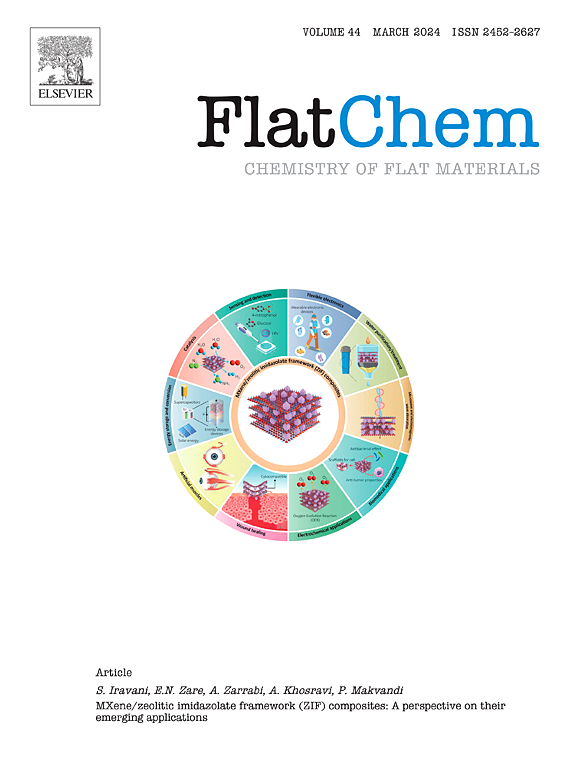Synthesis of porous MXene for efficient bifunctional electrocatalysis in overall water splitting: Hydrogen and oxygen evolution reactions
IF 6.2
3区 材料科学
Q2 CHEMISTRY, PHYSICAL
引用次数: 0
Abstract
Electrocatalytic water splitting is a key process for sustainable energy generation, but its large-scale implementation is hindered by the slow kinetics of the hydrogen evolution (HER) and oxygen evolution reactions (OER). This study introduces a design strategy for two-dimensional (2-D) MXene and porous MXene (P-MXene) nanostructures to enhance water splitting efficiency. By employing advanced etching and structural engineering, P-MXene nano structures with optimized porosity and increased surface area are fabricated, which improving the active site density and promoting rapid ion diffusion. Electrochemical characterizations demonstrate significantly reduced overpotentials and enhanced current densities for both HER and OER, consistently, P-MXene catalyst resulted in the overpotential reduction suggestively by 45 mV for HER and 110 mV for OER at anodic and cathodic current density of 10 m A cm−2, compared to MXene, surpassing traditional noble-metal catalysts. Furthermore, the P-MXene/NF device delivers the stable current density of 10 mA cm−2 for overall water splitting at 1.54 V and retained 92.2 % efficiency after 24 h. This work highlights the potential of porous MXene nanostructures in electrocatalysis, offering a scalable approach for the development of bifunctional electrocatalysts for next-generation energy conversion systems.

用于高效双功能电催化的多孔MXene的合成:氢和氧的析出反应
电催化水裂解是可持续能源生产的关键工艺,但析氢反应(HER)和析氧反应(OER)动力学缓慢阻碍了其大规模实施。本研究介绍了二维(2-D) MXene和多孔MXene (P-MXene)纳米结构的设计策略,以提高水的分解效率。采用先进的蚀刻技术和结构工程技术,制备了孔隙率优化、比表面积增大的P-MXene纳米结构,提高了活性位点密度,促进了离子的快速扩散。电化学表征表明,HER和OER的过电位显著降低,电流密度显著增强,与MXene相比,在阳极和阴极电流密度为10 m A cm - 2时,P-MXene催化剂的过电位降低了45 mV, OER的过电位降低了110 mV,超过了传统的贵金属催化剂。此外,P-MXene/NF装置在1.54 V下提供了10 mA cm−2的稳定电流密度,用于整体水分解,并在24小时后保持92.2%的效率。这项工作突出了多孔MXene纳米结构在电催化中的潜力,为下一代能量转换系统的双功能电催化剂的开发提供了可扩展的方法。
本文章由计算机程序翻译,如有差异,请以英文原文为准。
求助全文
约1分钟内获得全文
求助全文
来源期刊

FlatChem
Multiple-
CiteScore
8.40
自引率
6.50%
发文量
104
审稿时长
26 days
期刊介绍:
FlatChem - Chemistry of Flat Materials, a new voice in the community, publishes original and significant, cutting-edge research related to the chemistry of graphene and related 2D & layered materials. The overall aim of the journal is to combine the chemistry and applications of these materials, where the submission of communications, full papers, and concepts should contain chemistry in a materials context, which can be both experimental and/or theoretical. In addition to original research articles, FlatChem also offers reviews, minireviews, highlights and perspectives on the future of this research area with the scientific leaders in fields related to Flat Materials. Topics of interest include, but are not limited to, the following: -Design, synthesis, applications and investigation of graphene, graphene related materials and other 2D & layered materials (for example Silicene, Germanene, Phosphorene, MXenes, Boron nitride, Transition metal dichalcogenides) -Characterization of these materials using all forms of spectroscopy and microscopy techniques -Chemical modification or functionalization and dispersion of these materials, as well as interactions with other materials -Exploring the surface chemistry of these materials for applications in: Sensors or detectors in electrochemical/Lab on a Chip devices, Composite materials, Membranes, Environment technology, Catalysis for energy storage and conversion (for example fuel cells, supercapacitors, batteries, hydrogen storage), Biomedical technology (drug delivery, biosensing, bioimaging)
 求助内容:
求助内容: 应助结果提醒方式:
应助结果提醒方式:


